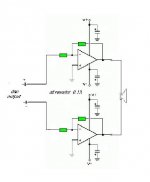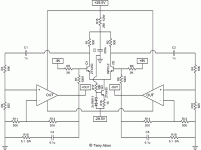hi!
i want to make the simpliest and smallest brigde (as symmetric as possible) amp,that why i choose chipamp ,it's to connect it to the symmetric output of a soundcard
so i make some search here,found some example but is there a better layout beetween
2 chip in no invert config
2 chip in invert config
1 invert 1 no invert
or another layout?
the need of power is about 20/30w ,the load is about 12ohms (2drivers serial)
someone can help me?
thanks!
fred
i want to make the simpliest and smallest brigde (as symmetric as possible) amp,that why i choose chipamp ,it's to connect it to the symmetric output of a soundcard
so i make some search here,found some example but is there a better layout beetween
2 chip in no invert config
2 chip in invert config
1 invert 1 no invert
or another layout?
the need of power is about 20/30w ,the load is about 12ohms (2drivers serial)
someone can help me?
thanks!
fred
You have three choices for a bridge configuration;
1- One works as noninverting and the other works as inverting. The inputs connected to global input. But in this case; to match output gains, you must have +1 X gain resistor on inverted side. For example, if you request total 20X gain then on inverted side you will have 10K Rf and 1K Ri while non inverted side has 9K Rf and 1K Ri.. This is the simplest way.
2- Two identific amplifiers (work in NI or I) and a balanced line driver (like DRV134) at input.
3- Also two identific amplifiers work with a full balanced input (XLR input)
Thats all.
1- One works as noninverting and the other works as inverting. The inputs connected to global input. But in this case; to match output gains, you must have +1 X gain resistor on inverted side. For example, if you request total 20X gain then on inverted side you will have 10K Rf and 1K Ri while non inverted side has 9K Rf and 1K Ri.. This is the simplest way.
2- Two identific amplifiers (work in NI or I) and a balanced line driver (like DRV134) at input.
3- Also two identific amplifiers work with a full balanced input (XLR input)
Thats all.
At that small amount of power there is no need for a bridged application. You can work with a single chip.
The chipamps inverting and a non-inverting inputs are perfect matches for the inverted and the non-inverted signal from the soundcard.
You get 20 to 30 W e. g. from LM1875, LM4700, TDA2040 or TDA2050.
The chipamps inverting and a non-inverting inputs are perfect matches for the inverted and the non-inverted signal from the soundcard.
You get 20 to 30 W e. g. from LM1875, LM4700, TDA2040 or TDA2050.
thank for replys,
Dxvideo, what a want to know is witch layout is the best in term of quality,if there is difference ?
since the soundcard use got fullbalanced output ,i prefer keep the signal like that (with the advantages!!)
Dxvideo, what a want to know is witch layout is the best in term of quality,if there is difference ?
since the soundcard use got fullbalanced output ,i prefer keep the signal like that (with the advantages!!)
It depends your soundcards specs..
In theory, less components means more sound quality.. However in real world, some other factors affect the overall system performance..
My suggestion is, use two identical LM1875 amp for each channel and drive directly from your XLR output. Use no buffer or balanced driver.. If you feel some loss of details then add OPA2134 buffers on each input.. If you have real symmetrical outputs, making a bridge amplifier is a piece of cake!
PS: You must match the gain resistors in a narrow range (may be %0.1) for good results...
In theory, less components means more sound quality.. However in real world, some other factors affect the overall system performance..
My suggestion is, use two identical LM1875 amp for each channel and drive directly from your XLR output. Use no buffer or balanced driver.. If you feel some loss of details then add OPA2134 buffers on each input.. If you have real symmetrical outputs, making a bridge amplifier is a piece of cake!
PS: You must match the gain resistors in a narrow range (may be %0.1) for good results...
If you want to use the inverting configuration, check out page 20 of the LM4780 datasheet for a more promising application.
In a bridged application 0,1% matched resistors have no advantage. Don't get confused with a parallel application, where close resistor matching is fundamental.
In a bridged application 0,1% matched resistors have no advantage. Don't get confused with a parallel application, where close resistor matching is fundamental.
pacificblue said:In a bridged application 0,1% matched resistors have no advantage. Don't get confused with a parallel application, where close resistor matching is fundamental.
Real symmetrical signal processing is not important? Ok %0.1 is a bit more than needed, but match values are important for symmetrical processing!
hi all!
"In theory, less components means more sound quality" that's where y wanna go
pacificblue,not confusing between bridge and parallel,but it seems to me (and other) that in the 2 cases it maybe better to approach a "perfect"match of the 2 part of the bridge
isn't it?
"In theory, less components means more sound quality" that's where y wanna go
pacificblue,not confusing between bridge and parallel,but it seems to me (and other) that in the 2 cases it maybe better to approach a "perfect"match of the 2 part of the bridge
isn't it?
Hi,
do you need to drive the two loads in series?
What about one amp dedicated to each load?
30W into 12ohms from a bridged pair is just the same as 15+15W into the two 6ohm loads and it's far less difficult to get each mono amp working properly.
As pointed out already, a single 3886 will drive 30W into 12r (6r0+6r0) if you design the amp and power supply correctly. It's the same voltage as 45W into 8r0.
do you need to drive the two loads in series?
What about one amp dedicated to each load?
30W into 12ohms from a bridged pair is just the same as 15+15W into the two 6ohm loads and it's far less difficult to get each mono amp working properly.
As pointed out already, a single 3886 will drive 30W into 12r (6r0+6r0) if you design the amp and power supply correctly. It's the same voltage as 45W into 8r0.
Then don't go bridged. 50% less components should be hard to beat.hobby1 said:"In theory, less components means more sound quality" that's where y wanna go
"Maybe" means you don't know, if it has any audible effect at all. If you use 0,1% matched resistors, may I assume that you will also use 0,1% matched DC blocking capacitors? And 0,1% matched loudspeakers? Because if you don't, resistor matching is a waste of time and money.hobby1 said:it maybe better to approach a "perfect"match of the 2 part of the bridge
isn't it?
thanks for reply,
first i had to say that,i make this choice because my idea is to keep the symmetry of the signal all along the analog line , with a minimun of components on the travel ,something simple but qualitative, and 4 resistor with low tolerance to set gain and current around the chip is a qualitative way,and i can have them easily
that said, on the simple schema above what i got to add to improve quality?
cheer
first i had to say that,i make this choice because my idea is to keep the symmetry of the signal all along the analog line , with a minimun of components on the travel ,something simple but qualitative, and 4 resistor with low tolerance to set gain and current around the chip is a qualitative way,and i can have them easily
that said, on the simple schema above what i got to add to improve quality?
cheer
i have find what i was looking for
http://www.diyaudio.com/forums/showthread.php?s=&threadid=36398&highlight=
some explanations about symmetric signal...
http://www.passdiy.com/pdf/articles/susy.pdf
http://www.passdiy.com/pdf/balzenpre.pdf
cheer
http://www.diyaudio.com/forums/showthread.php?s=&threadid=36398&highlight=
some explanations about symmetric signal...
http://www.passdiy.com/pdf/articles/susy.pdf
http://www.passdiy.com/pdf/balzenpre.pdf
cheer
Attachments
- Status
- Not open for further replies.
- Home
- Amplifiers
- Chip Amps
- need help for bridge or symmetric amp

